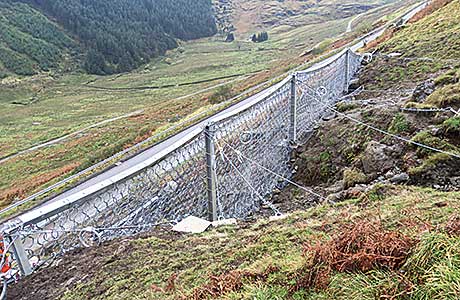
THE A83 at the Rest and Be Thankful in Argyll hasn’t given drivers much to be thankful for in recent years as a series of landslides has led to major disruption and lengthy diversions.
IN October 2007 around 400 tonnes of material were deposited on the road, closing the route for 17 days. In September 2009 the road was closed again, for two days, after more than 1,000 tonnes landed following a more significant event. Since those two incidents there has been continued movement of the slopes above the road with further slips in 2011 and 2012.
Not surprisingly, the A83 has been under intensive investigation. It was identified as one of the highest risk sites for debris flow in a report, the Scottish Road Network Landslides Study, by Transport Scotland and TRL. The implementation report was published in 2008.
According to the British Geological Survey the geology is described as steeply sloping ground underlain by rocks of the Beinn Bheula Schist Formation. These are composed of psammite and semi-pelite rocks that are metamorphic in origin and made up largely of quartz, feldspar and mica minerals. The rocks are commonly intensely foliated and spectacularly folded; extensive quartz lenses and veins also occur.
The bedrock plays little part in the landslide activity on these slopes; instead the recent landslides have largely been associated with slope deposits, including peat and topsoil as well as underlying layers of colluvium. The colluvium comprises sandy to gravelly silts and clays, with varying amounts of cobbles and boulders. The colluvium deposits on this slope represent earlier phases of slope instability.
Following the 2009 event a requirement was identified for up-slope protection. Specialist geotechnical contractor BAM Ritchies, working with barrier supplier Geobrugg of Switzerland, and roads maintenance contractor Scotland Transerv developed a solution of an 80-metre long, four-metre high shallow landslide barrier and a 15-metre wide VX ‘in-channel’ debris flow barrier nearby. They were installed by BAM Ritchies in early 2010.
However, since then there has been evidence of continued high risk in other areas upslope as identified by the monitoring programme implemented by Scotland Transerv comprising laser scanning surveys and movements on the tiltmeter and piezometers instrumentation, including some installed by BAM Ritchies at the same time as the barriers in 2010.
This increased risk was emphasised by a further slip in 2011 when a translational landslide degraded into a flow occurring to the south-east of the 2007/2009 landslides followed by small landslide – 50 tonnes – in February this year, setting off tiltmeters alarms. Although no debris from the landslide reached the road, the A83 was closed for three days as a precaution.
As a result of all this new activity Transport Scotland funded an additional phase of protection works and instructed BAM Ritchies to design and install another shallow landslide barrier and a further debris flow barrier further down the valley at a particularly high-risk area. The work took place during the summer and comprises an 88-metre Geobrugg SL-150 shallow landslide barrier, a 38-metre wide Geobrugg UX-120-H6 debris barrier and a smaller ‘in-channel’ VX barrier. Anchors used include 35mm and 43mm galvanised GEWI + bars installed to depths of between eight and 16 metres.
Drilling of anchors was carried out using a combination of A65 crawler-mounted drill rig and Tirfor supported Ripamonti drilling rig using a down the hole hammer. Specially-trained BAM Ritchies personnel erected the barriers while a 360º telehandler was used to lift plant and equipment up slope and assemble the SL barrier, so reducing the requirement for manual handling.
Circumstances during the works were described by the contractor as “difficult” with further slips taking place in the vicinity of the new installations in August, one of which closed the road for two days when around 1,000 tonnes of slip material was deposited on the road. Despite that, work on the latest two barriers is now complete, Stuart Jackman, BAM Ritchies’ senior geotechnical engineer, commented: “We are pleased to successfully complete this second set of technically advanced barriers despite the very adverse summer rainfall conditions and high risk of further landslides and debris flows.”










